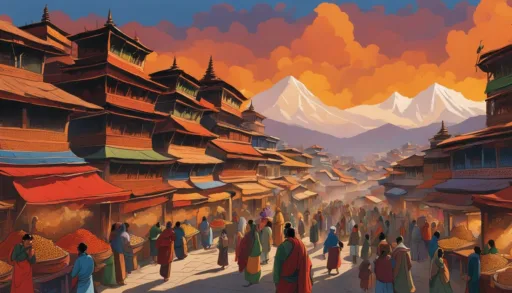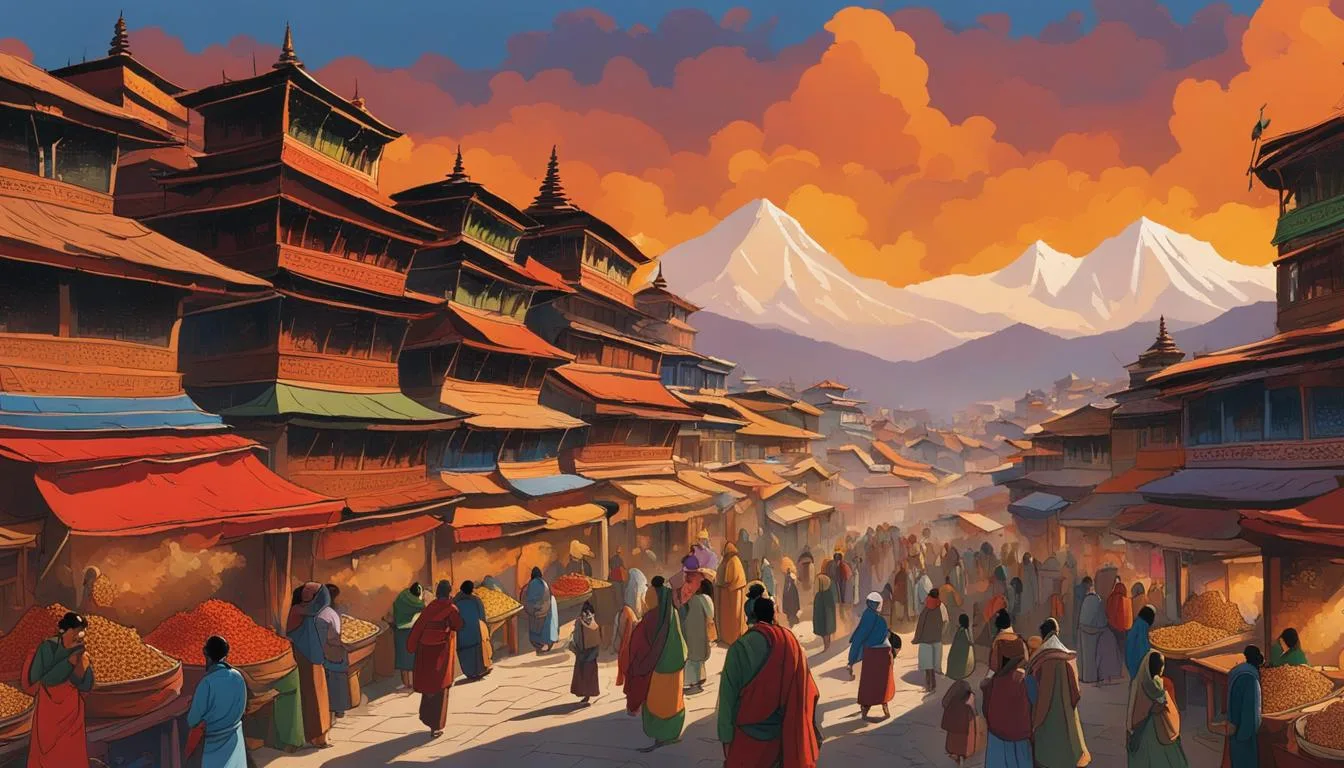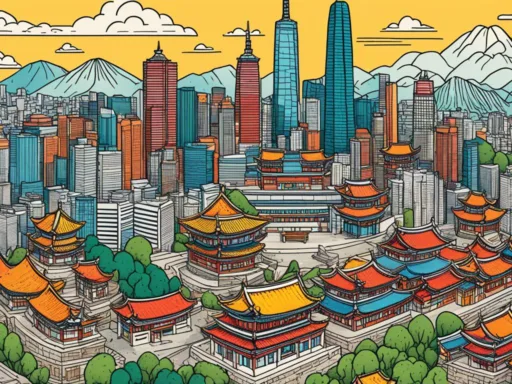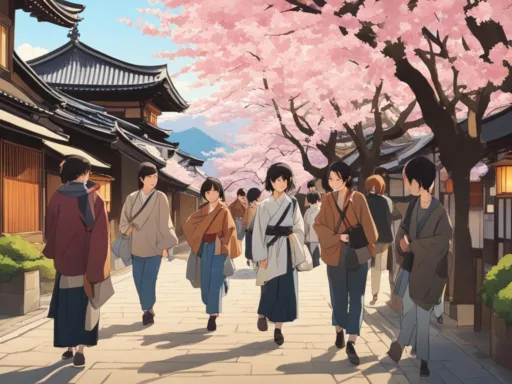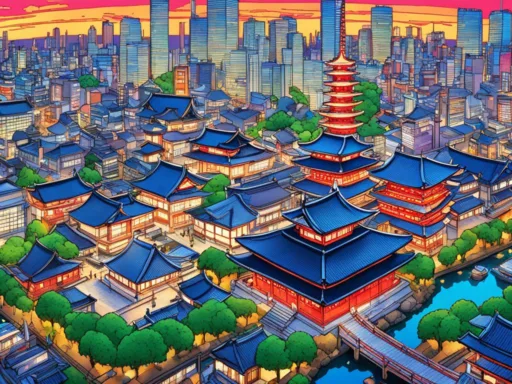Are you ready to embark on an extraordinary journey through the rich cultural tapestry of Kathmandu? Discover the hidden treasures of Nepal’s capital city as we delve into its historical sanctuaries, vibrant local culture, and mouthwatering Nepalese cuisine. From exploring ancient cities to immersing yourself in the spiritual birthplace of Buddha, Kathmandu offers an enchanting adventure like no other.
Uncover the secrets of the Kathmandu Valley, where ancient cities stand as testaments to the region’s intriguing history. Immerse yourself in the cultural heritage of Patan and Bhaktapur, known as the ‘City of Beauty’ and the ‘City of Devotees,’ respectively. Marvel at the stunning temples and palaces that have withstood the test of time, and be captivated by the charm of Bandipur, a timeless hilltop town.
But that’s not all – prepare to be swept away by the natural beauty of Pokhara, nestled amidst the Annapurna mountain range. Cruise along the tranquil Phewa Lake and soak in the breathtaking views of the snow-capped peaks. And don’t forget to savor the delectable flavors of Nepalese cuisine, renowned for its unique spices and mouthwatering dishes.
So why wait? Let’s embark on this unforgettable adventure and discover the wonders of Kathmandu!
Key Takeaways:
- Explore the ancient cities of the Kathmandu Valley and witness the region’s rich history and cultural heritage.
- Uncover the spiritual significance of Lumbini, the birthplace of Buddha, and immerse yourself in its peaceful ambiance.
- Experience the timeless charm of Bandipur, a hilltop town that showcases Nepal’s unique Newari architecture.
- Marvel at the breathtaking natural beauty of Pokhara, nestled amidst the majestic Annapurna mountain range.
- Indulge in the flavors of Nepalese cuisine and savor the unique spices and mouthwatering dishes of the region.
The Ancient Cities of the Kathmandu Valley
The Kathmandu Valley is a treasure trove of history and cultural heritage, with a cluster of ancient cities that showcase the rich heritage of Nepal. Let’s explore the captivating ancient cities that make this valley a historical sanctuary.
Kathmandu: The Cultural Epicenter
Kathmandu, the capital city of Nepal, is the cultural epicenter of the Kathmandu Valley. Its Kathmandu Durbar Square, a UNESCO World Heritage site, is a testament to the city’s glorious past. Dating back to the 12th century, this iconic square is home to temples, palaces, and courtyards that exude architectural brilliance from a bygone era.
Patan (Lalitpur): The City of Beauty
Patan, also known as Lalitpur, is renowned as the “City of Beauty.” It is celebrated for its exquisite craftsmanship, which is beautifully showcased in its temples and palaces. The city’s Durbar Square is a mesmerizing blend of intricate carvings, delicate woodwork, and stunning pagodas that narrate the tales of its ancient glory.
Bhaktapur: The City of Devotees
Bhaktapur, often referred to as the “City of Devotees,” transports visitors to a world frozen in time. Its Durbar Square is a living museum, preserving the architectural grandeur and cultural heritage of ancient Nepal. The city’s well-preserved courtyards, palaces, and temples reflect the rich cultural traditions and spiritual devotion that have been passed down through generations.
Each of these ancient cities within the Kathmandu Valley offers a unique charm and character, taking visitors on a captivating journey through Nepal’s architectural heritage and cultural legacy.
Lumbini: The Birthplace of Buddha
Lumbini, a sacred site in Nepal, holds immense significance in the history of Buddhism as the birthplace of Siddhartha Gautama, better known as Buddha. This ancient pilgrimage site attracts millions of visitors from around the world who seek spiritual enlightenment and a deeper understanding of Buddhist teachings.
At the heart of Lumbini lies the Maya Devi Temple, which is believed to be the exact spot where Queen Maya Devi gave birth to Buddha. Stepping into the temple, visitors are transported back in time to an era of profound significance. The atmosphere is filled with a sense of serenity and reverence, inviting pilgrims to embark on a spiritual journey.
The site also showcases the iconic Ashoka Pillar, erected by the Indian Emperor Ashoka in 249 BCE to commemorate Buddha’s birth. This pillar stands as a testament to the historical and cultural significance of Lumbini, representing the spread of Buddhism and its enduring impact on humanity.

Visiting Lumbini is not just a physical journey but a profound spiritual experience. As pilgrims explore the sacred grounds, they can meditate, reflect, and pay homage to the enlightened being who played a pivotal role in shaping the course of Buddhism. The tranquil ambiance, combined with the awe-inspiring architecture, creates a setting conducive to introspection and self-discovery.
For those seeking a deeper connection with Buddhism and a desire to immerse themselves in the birthplace of Buddha, Lumbini is a must-visit destination. It offers a transformative experience that transcends time and bridges the gap between the physical and spiritual realms.
Bandipur: A Timeless Hilltop Town
Discover the charm of Bandipur, a picturesque hilltop town that showcases Nepal’s rich cultural heritage and Newari architecture.
Nestled between Kathmandu and Pokhara, Bandipur is a hidden gem that offers a unique experience for travelers seeking a glimpse into Nepal’s past. This hilltop town boasts well-preserved Newari architecture, transporting visitors to a bygone era. As you wander through Bandipur’s narrow streets, you’ll be captivated by the beautifully restored traditional houses adorned with intricate woodwork and carvings.
Bandipur’s hilltop location not only provides a serene and peaceful ambiance but also offers breathtaking views of the majestic Himalayas. Nature lovers can indulge in the picturesque landscapes and heavenly sunsets, creating unforgettable memories.
“Bandipur is a testament to the architectural brilliance of the Newari people. The town is a living museum, where heritage architecture is beautifully preserved.”
Immerse yourself in the local culture by interacting with the warm and welcoming Newari community. Taste the delicious local cuisine, known for its unique flavors and use of indigenous ingredients. Explore the vibrant bazaars and witness firsthand the traditions and customs that have been passed down through generations.
Bandipur is not just another destination; it’s a journey back in time, where the beauty of Newari culture and heritage architecture intertwine with the stunning natural landscapes. Whether you’re a history enthusiast, nature lover, or simply seeking a tranquil escape, Bandipur has something for everyone.
Experience the timeless charm of Bandipur while enjoying stunning views of the Himalayas.
Pokhara: A Fusion of Natural Beauty and Culture
Pokhara, a captivating city nestled beside the tranquil Phewa Lake and surrounded by the majestic Annapurna mountain range, offers a perfect blend of breathtaking natural beauty and a vibrant cultural tapestry. This lakeside city is a must-visit destination for those seeking the perfect balance between nature and culture.
Visitors to Pokhara can enjoy serene boat rides on Phewa Lake, immersing themselves in the peaceful ambiance and taking in the stunning views of the Himalayas. The reflection of the mountains on the clear waters of the lake creates a picture-perfect setting that is truly mesmerizing.
Adding to its charm, Pokhara is also a hub of cultural activities. Travelers can explore the traditional bazaars and temples, offering a glimpse into the rich local culture. The traditional craftsmanship, vibrant festivals, and warm hospitality of the people contribute to the city’s vibrant cultural tapestry.
The juxtaposition of the natural wonders and cultural treasures in Pokhara creates a unique experience for visitors. Whether it’s paragliding over the picturesque landscape, trekking through the Annapurna region, or simply taking a leisurely stroll around the city, Pokhara offers something for every traveler.

With its awe-inspiring natural beauty, cultural richness, and warm hospitality, Pokhara is sure to leave a lasting impression on anyone fortunate enough to visit.
Unveiling Kathmandu’s Rich History and Culture
Kathmandu, the capital city of Nepal, has a rich and storied history that spans centuries. The city has been ruled by various dynasties, each leaving behind a unique imprint on its cultural fabric. From the Licchavi dynasty in the 1st century A.D. to the Malla dynasty, known for its splendid temples and statues, Kathmandu’s heritage is a testament to the artistic excellence of its rulers.
One of the pivotal figures in Kathmandu’s history is King Prithvi Narayan Shah, who led the Shah dynasty. His vision and leadership unified Nepal into a single kingdom and protected it from external threats.
During the mid-19th century, the Rana dynasty rose to power, bringing significant political changes to Nepal. However, it was the democracy movement of the early 1950s that marked a turning point in Nepal’s political landscape. The movement led to the end of the Rana rule and the establishment of a democratic system, making Nepal a Federal Democratic Republic state.
The Dynasties of Kathmandu
| Dynasty | Period | Significance |
|---|---|---|
| Licchavi dynasty | 1st century A.D. – 9th century A.D. | Developed an organized feudal socio-economic structure and a rich religious and cultural legacy. |
| Malla dynasty | 12th century A.D. – 18th century A.D. | Known for their patronage of art, architecture, and trade, resulting in the construction of exquisite temples, palaces, and artistic masterpieces. |
| Shah dynasty | 1768 – 2008 | Unified Nepal into a single kingdom and protected it from external threats. |
Kathmandu’s history is a fascinating journey through the rise and fall of dynasties, the preservation of cultural heritage, and the pursuit of democracy. Today, the city stands as a testament to the resilience and vibrancy of the Nepalese people.
“The history of Kathmandu is a tapestry woven with the threads of ancient dynasties, political movements, and cultural traditions.” – Unknown
- Licchavi dynasty – Ruled Kathmandu from the 1st century A.D. to the 9th century A.D.
- Malla dynasty – Governed Kathmandu from the 12th century A.D. to the 18th century A.D.
- Shah dynasty – Ruled Nepal from 1768 to 2008.
Nepal’s Democracy Movement
“The democracy movement of the early 1950s marked a turning point in Nepal’s history, paving the way for political change and the establishment of a Federal Democratic Republic state.” – Unknown
The democracy movement in Nepal during the early 1950s was a watershed moment in the country’s political landscape. It saw the end of the Rana rule, which had lasted for over a century, and the dawn of a new era characterized by democratic governance. The movement brought together people from all walks of life, united in their pursuit of political freedom and equal rights. Through collective efforts and determination, Nepal emerged as a Federal Democratic Republic state, providing its citizens with a voice in shaping their own destiny.
Exploring the Cultural Treasures of Kathmandu
Kathmandu, the capital city of Nepal, is renowned for its rich cultural heritage, featuring an array of temples, palaces, and historical sites. These architectural marvels serve as testaments to the exquisite craftsmanship that flourished in the Kathmandu Valley, leaving visitors in awe of their intricate design and enduring beauty. Among the many cultural treasures, the Changunarayan temple stands out as a prime example of the valley’s artistic prowess.
The Changunarayan temple, located 15 km northeast of Kathmandu, is an ancient Hindu temple dedicated to Lord Vishnu. It is one of the oldest temples in Nepal and is recognized as a UNESCO World Heritage site. This magnificent temple is a testament to the skills of the Newari craftsmen, featuring intricate wood carvings, stone statues, and beautiful pagodas.
The city’s Durbar Squares, including Kathmandu Durbar Square, Patan Durbar Square, and Bhaktapur Durbar Square, offer visitors a glimpse into the architectural brilliance of the ancient Newari craftsmen. These squares served as the royal palaces of the Malla kings and are adorned with stunning palaces, temples, and courtyards, showcasing the rich history and cultural heritage of the Kathmandu Valley.
Kathmandu Durbar Square is the heart of the city and home to numerous historical sites, including the Hanuman Dhoka Palace, Kumari Ghar (the residence of the living goddess Kumari), and Taleju Temple. Meanwhile, Patan Durbar Square boasts intricately carved wooden pillars, temples, and statues, showcasing the Newari craftsmanship at its finest. Lastly, Bhaktapur Durbar Square, known as the ‘City of Devotees,’ offers a wealth of architectural marvels, including the famous Nyatapola Temple and the golden gate of the 55 Window Palace.
Architectural Highlights of Kathmandu
| Site | Key Features |
|---|---|
| Changunarayan temple | Intricate wood carvings, stone statues, and pagodas |
| Kathmandu Durbar Square | Hanuman Dhoka Palace, Kumari Ghar, Taleju Temple |
| Patan Durbar Square | Intricately carved wooden pillars, temples, and statues |
| Bhaktapur Durbar Square | Nyatapola Temple, golden gate of 55 Window Palace |
These cultural treasures of Kathmandu offer a fascinating journey through Nepal’s rich history and provide a deeper understanding of the country’s cultural heritage. Visitors can marvel at the meticulous craftsmanship, explore the architectural wonders, and immerse themselves in the spiritual and artistic legacy that defines Kathmandu.
Delving into the Spiritual Significance of Lumbini
Lumbini, known as the birthplace of Buddha, holds immense spiritual importance for Buddhists around the world. Located in present-day Nepal, Lumbini is believed to be the place where Queen Maya Devi gave birth to Siddhartha Gautama, who later attained enlightenment and became known as Buddha. One of the most revered sites in Lumbini is the Maya Devi Temple, which stands at the exact spot where Buddha was born.
The Maya Devi Temple serves as the focal point for pilgrims who visit Lumbini to pay their respects and seek solace. Its spiritual aura resonates with a sense of tranquility and reverence, inviting visitors to connect with their inner selves and reflect on the teachings of Buddha. The temple’s architecture and design reflect the cultural heritage of the region, immersing pilgrims in the rich history and spirituality of Lumbini.
Exploring the Monastic Zones and the Ashoka Pillar
Besides the Maya Devi Temple, Lumbini is also home to several monastic zones that house Buddhist monasteries and meditation centers. These monastic zones provide a serene environment for individuals to deepen their spiritual practice and engage in contemplation. The monasteries, built by various Buddhist communities from around the world, showcase the diversity of Buddhist traditions and promote interfaith dialogue.
Another prominent landmark in Lumbini is the Ashoka Pillar, which was erected by the Indian Emperor Ashoka in 249 BCE to commemorate Buddha’s birth. The pillar bears an ancient inscription that marks Lumbini as the birthplace of Buddha and serves as a testament to the historical significance of the site. Visitors can marvel at this ancient artifact and gain a deeper appreciation for the lasting impact of Buddha’s teachings.
“The journey to Lumbini is not just a physical pilgrimage but also an inner exploration of one’s faith and spirituality. The peaceful ambiance and sacred sites create an atmosphere conducive to introspection and self-discovery.”
A Pilgrimage of Insight and Enlightenment
A visit to Lumbini is not merely a sightseeing trip, but a pilgrimage of insight and enlightenment. It offers an opportunity to delve into the life and teachings of Buddha, gaining a deeper understanding of the path to spiritual awakening. As visitors explore the sacred grounds and engage with the local community, they can witness firsthand the impact of Buddhism on the lives of devotees and appreciate its enduring relevance in the modern world.
| Key Highlights of Lumbini’s Spiritual Significance |
|---|
| Birthplace of Siddhartha Gautama (Buddha) |
| Maya Devi Temple marking the exact spot of Buddha’s birth |
| Monastic zones hosting Buddhist monasteries and meditation centers |
| Ashoka Pillar erected by Emperor Ashoka as a commemoration |
A journey to Lumbini is a soul-stirring experience that leaves a lasting impression on pilgrims. It is a place where spirituality and history converge, providing a profound connection to the life and teachings of Buddha. Whether one seeks personal enlightenment or a deeper understanding of the Buddhist faith, Lumbini offers an oasis of spiritual rejuvenation and introspection.
Discovering Bandipur’s Timeless Charm
Bandipur, a charming hilltop town, is a hidden gem renowned for its well-preserved Newari architecture. As you stroll along the main street, you’ll be captivated by beautifully restored traditional houses adorned with intricate woodwork and carvings, showcasing the craftsmanship of the Newar people.
One of the highlights of Bandipur is Tundikhel, a vast open area that offers panoramic views of the majestic Himalayas. This breathtaking vantage point was once a parade ground for Gurkha soldiers and continues to be a favorite spot for locals and visitors alike to soak in the mesmerizing mountain scenery.
The town’s heritage architecture and serene ambiance create a unique atmosphere that transports you to a bygone era. Immerse yourself in the charming streets, indulge in the local cuisine, and experience the warmth of the Nepalese hospitality. Bandipur’s timeless charm is sure to leave a lasting impression on your heart and soul.
Quoting a Local Resident:
“Bandipur is like a time capsule, preserving the rich history and Newari culture of Nepal. The beautiful architecture and stunning mountain views make it a truly enchanting destination.” – Maya Rai, Bandipur resident
What to Experience in Bandipur:
- Wander the streets lined with traditional Newari houses
- Visit the Siddha Gufa, one of the largest caves in Nepal
- Take a hike to Ramkot Village for a stunning sunrise or sunset view
- Explore the local markets and try delectable Newari cuisine
- Embark on a nature walk to enjoy the tranquility of the surrounding hills
Exploring the Beauty of Pokhara
Pokhara, a destination famed for its natural splendor, offers a visual feast for the eyes. Situated against the backdrop of the majestic Annapurna mountain range, the city bewitches visitors with its breathtaking landscapes and serene ambiance. One of Pokhara’s crown jewels is the picturesque Phewa Lake, which provides a tranquil respite from the bustling city life.
The crystal-clear waters of Phewa Lake mirror the awe-inspiring beauty of the surrounding mountains, creating a mesmerizing reflection that captivates all who behold it. For a truly enchanting experience, visitors can indulge in peaceful boat rides on the lake, drifting along the calm waters while soaking in the panoramic views. Whether it’s the early morning mist enveloping the mountains or the golden hues of a picturesque sunset, each moment spent on Phewa Lake is a moment of pure magic.
Pokhara is a haven for adventure enthusiasts, with a myriad of exhilarating activities to embark on. Paragliding over the city offers a bird’s-eye view of the stunning landscapes, while trekking trails lead adventurers to hidden gems nestled amidst the mountains. For those seeking an adrenaline rush, white-water rafting in the nearby rivers provides an exhilarating experience like no other.
Immersing oneself in Pokhara’s local culture is an experience not to be missed. The city boasts a vibrant tapestry of traditions, and visitors can explore ancient temples that pay homage to the city’s spiritual heritage. From exploring the serene Bindhyabasini Temple to marvelling at the intricate architecture of the World Peace Pagoda, Pokhara offers a cultural journey that is as enriching as it is awe-inspiring.
Experience the beauty of Pokhara, where nature’s magnificence and cultural treasures harmoniously coexist.
Indeed, Pokhara’s natural beauty, with the Annapurna mountain range and Phewa Lake as its crown jewels, has rightfully earned its place as a must-visit destination for travelers seeking a unique blend of adventure, tranquility, and cultural immersion.
Top Attractions in Pokhara
| Phewa Lake | Annapurna Mountain Range |
|---|---|
| Enjoy boat rides on the serene Phewa Lake and experience its mesmerizing reflection of the surrounding mountains. | Marvel at the majestic Annapurna mountain range, offering stunning panoramic views and trekking opportunities. |
| World Peace Pagoda | Bindhyabasini Temple |
| Visit the iconic World Peace Pagoda and admire its serene surroundings and panoramic views of Pokhara. | Explore the Bindhyabasini Temple and immerse yourself in the spiritual ambiance of Pokhara’s revered sacred site. |
Best Time to Visit Kathmandu
When planning a trip to the captivating city of Kathmandu, it is essential to consider the best time to visit to ensure a memorable and enjoyable experience. Understanding the climate and seasonal variations will allow you to make informed decisions and make the most of your trip to this incredible destination.
Kathmandu Climate
Kathmandu experiences a subtropical highland climate, characterized by warm summers and cool winters. The city is situated at an altitude of approximately 1,400 meters (4,600 feet) above sea level, contributing to its mild and pleasant weather conditions.
Monsoon Season
The monsoon season in Kathmandu spans from June to August, with heavy rainfall and occasional thunderstorms. While the cityscape takes on a lush and vibrant appearance during this time, the frequent rain showers may impede outdoor activities and hinder visibility. It is advisable to consider an alternative time to visit if you prefer to avoid the monsoon season.
Peak Season
The peak tourist season in Kathmandu falls during the autumn months, particularly September and October. This period sees clear skies and moderate temperatures, providing excellent conditions for sightseeing and outdoor adventures. The surrounding Himalayas offer breathtaking views, making it an ideal time for trekking and mountain expeditions.
Ideal Time to Visit Kathmandu
The ideal time to visit Kathmandu is during the spring and autumn seasons, which span from September to November and March to May. During these months, the weather remains mild and pleasant, with comfortable temperatures and less rainfall. This makes it an ideal time for exploring the cultural and historical treasures of the city, such as the ancient temples and palaces.
By planning your visit to Kathmandu during the spring or autumn seasons, you can optimize your experience and enjoy the beauty of this remarkable city without the challenges posed by extreme weather conditions. Whether you are an adventure seeker, a history enthusiast, or a nature lover, Kathmandu offers a myriad of experiences that will leave you awe-inspired and longing to return.
| Season | Weather | Best Features |
|---|---|---|
| Spring (March to May) | Mild temperatures, occasional rainfall | Blooming flowers, picturesque landscapes |
| Monsoon (June to August) | Heavy rainfall, occasional thunderstorms | Lush greenery, fewer crowds |
| Autumn (September to November) | Moderate temperatures, clear skies | Breathtaking views of the Himalayas, ideal for trekking |
Conclusion
Kathmandu, known for its historical sanctuaries, rich cultural heritage, and vibrant local culture, is a destination that promises a unique and unforgettable experience. The city offers a plethora of must-see attractions, from exploring the ancient cities of the Kathmandu Valley to immersing oneself in the spiritual significance of Lumbini, the birthplace of Buddha.
One cannot miss the opportunity to taste the flavors of Nepalese cuisine, known for its aromatic spices and diverse culinary traditions. The city’s bustling markets and street food stalls offer a tantalizing array of dishes that will delight even the most discerning taste buds.
In addition to its cultural and gastronomic offerings, Kathmandu is also blessed with breathtaking natural beauty. Nestled in the lap of the Himalayas, the city provides a stunning backdrop for outdoor enthusiasts. Whether it’s trekking in the Annapurna mountain range or boating on the tranquil Phewa Lake in Pokhara, the natural landscapes surrounding Kathmandu are a sight to behold.
Finally, the warm hospitality of the Nepalese people adds to the allure of this enchanting city. The locals are known for their friendly nature and deep-rooted cultural traditions, which they are more than happy to share with visitors. A journey through Kathmandu is not just a trip, but an immersive experience that will leave a lasting impression on your heart and soul.
